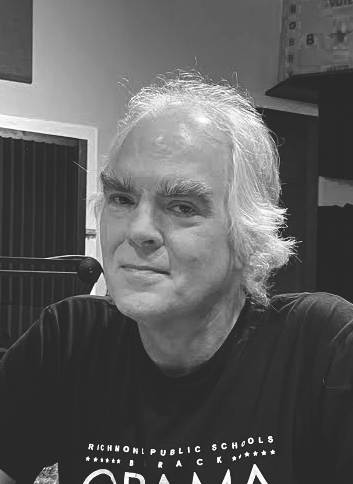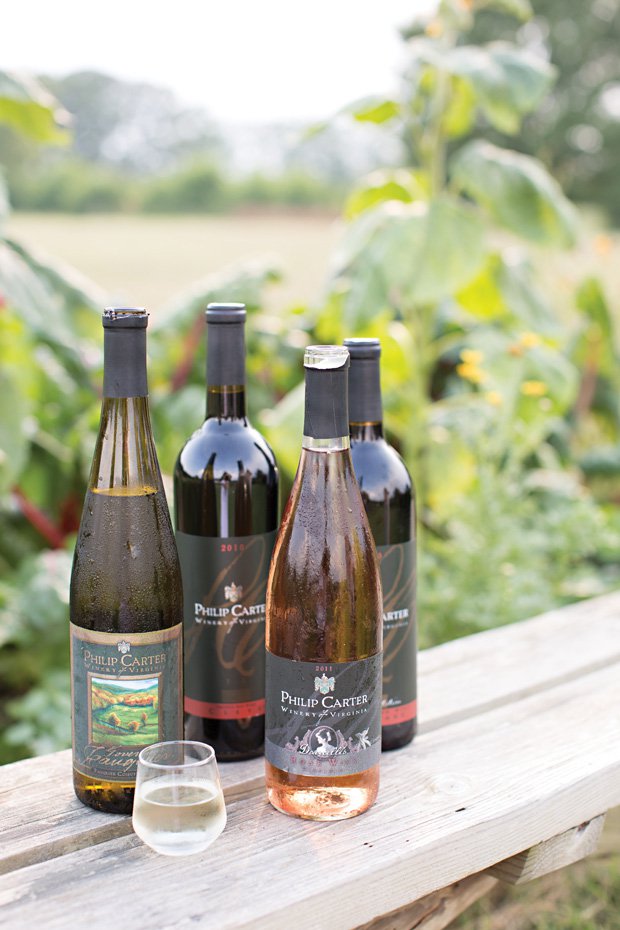From smoking to steeping, Virginia distillers are all about bold new flavor.

Photo by Fred + Elliott
Some people think of Rick Wasmund as more of a mad scientist than a distiller. “We’re not only smoking with the wood, we’re infusing the liquid with it,” says the owner of Copper Fox Distillery. Wasmund uses charred fruit branches both asa seasoning medium during the kiln drying step of whiskey production and as a “maturing catalyst” while the liquor ages.
Fifteen years ago, the former insurance agent traveled to Bowmore, Scotland—the Vatican of Scotch whiskey production—and learned how to make hooch the traditional way. When he set up shop in 2006 in an old apple juice plant in Sperryville, he started malting his own barley, which was a bit unheard of (professional malting houses normally do that work), and experimenting with burning oak. “I went [to Scotland] to figure out if this was really something that I wanted to do,” he says. “And because no one in America was malting their own barley, I sort of had to go. The whole point of the process was that we would malt the barley with different smokes.”

Rick Wasmund
Photo courtesy of Copper Fox Distillery
Wasmund’s single malt whiskeys—available in apple, cherry, and peach wood—are malted, distilled, aged, and bottled at Copper Fox, which now has a second location in the former Lord Paget Hotel in Williamsburg (they use the hotel pool to cool the stills). The obsessive, time-consuming detailing has given Wasmund a reputation—Esquire has called him “the Doc Brown of distilling”—but the proof’s in the whiskey. Wasmund’s Peach, in particular, is a mellow, immensely sippable delight.
Wasmund set up shop at a time when craft distilleries were less than an industry in Virginia. Now there are more here—55 and counting—than in Kentucky or Tennessee, and many operations, established and new, are helping to push the palate on how whiskey can taste. Using unique smoking and aging methods, bold flavor infusions, and even ingredients that are way out of the norm, Virginia is at the vanguard of tricked-out whiskeys.
“Within the last five years, there has been more of a modern approach to craft spirits,” says Amy Ciarametaro, executive director of the Virginia Distillery Association. “There’s a real willingness to explore beyond the traditional methods.”
Aging whiskey in a charred oak barrel is, in part, what makes it bourbon. But what if the liquid rests in a cask seasoned with beer, cider, or even coffee? The Lovingston-based Virginia Distillery Co. makes an award-winning Virginia-Highland blend incorporating Virginian and Scottish whiskeys and offers distinct flavor variations—a Brewer’s Batch, Cider Cask, and Coffee Cask.

Virginia Distillery Co. Cider Cask Finished Virginia-Highland Whisky
Photos courtesy of Virginia Distillery Co.

Barrels at Virginia Distillery Co.

A copper still at Virginia Distillery Co.
The current trend in flavorings is being driven “by smaller craft producers who have the ability to innovate,” says VDC’s Marlene Steiner. “We get the whiskey to where it’s really great, but then we add an extra step that gives a little nuance.” It involves a barrel exchange with local businesses like Charlottesville’s Snowing in Space coffee company. “Both sides benefit. They get this really unique whiskey-flavored coffee, and we get this coffee-influenced whiskey. And we just keep exchanging the barrels back and forth, refreshing it with each exchange.” The distillery does similar exchanges with Charlottesville’s Three Notch’d Brewing, Blue Bee Cider in Richmond, and Potter’s Craft Cider in Free Union.
Barrel exchanges add subtle notes to the whiskey. But sometimes the taste is meant to announce itself. MurLarkey Distilled Spirits in Bristow offers 10 varieties of its traditional whiskey that feature more prominent flavor infusions. “Each one has its own nose, its own flavor,” says MurLarkey’s general manager, Jack Larkin. The distillery creates the bolder notes by pouring 90-percent corn whiskey into used wine barrels and then placing the flavorings in a brewer’s bag and steeping them in the liquid, like a tea. “We have a lemon whiskey and an orange whiskey, using dehydrated organic lemon or orange peel, and our banana whiskey uses dehydrated baby bananas.” The company also recently unveiled a Three-Tea whiskey and a honey-infused variety.
So what do the aficionados think? “There are certain traditionalists that really enjoy their classic brown whiskey,” Larkin says. “But this is a new category emerging. And the result is that people who drink cocktails are now drinking whiskey cocktails, and folks who don’t normally drink whiskey are enjoying the infused flavors, so it’s attracting new people to whiskey.”
Sometimes, he admits, the infusions don’t work. “We experimented with a root beer whiskey. It was tasty but it was tough to scale, not as consistent, and the dark color was a challenge. It was tough to make cocktails with such a flavor-forward spirit.”

Belle Isle Craft Spirits Cold Brew Coffee moonshine
Photo courtesy of Belle Isle Craft Spirits
If you’re thinking that, with all these new flavorings, the line between distiller and bartender is getting thinner, you wouldn’t be wrong, says Greg Brooks. “What I used to do in a pot, for the bar, I now do in a 4,000-liter tank,” admits the production manager for Richmond’s Belle Isle Craft Spirits and former bartender. “I’m taking the flavors and letting them sit in that spirit for 24 hours to seven days, depending on what it needs, imparting all of the flavor from the ingredients.”
The result is different moonshine variations like Cold Brew Coffee, Honey Habanero, Ruby Red Grapefruit, and the new Blood Orange, which may be Belle Isle’s best yet. “I don’t think I even knew what a blood orange was a year ago,” says Brooks. “But it turned out to be perfect.”
Most Virginia craft distilleries are trying out unique flavor offerings, but some are more radical than others. Nelson County’s Silverback Distillery offers a honey-liqueur rye whiskey and a Blackback Bourbon that promises the “ultimate butterscotch bomb.” In Richmond, there’s a hint of the sea in James River Distillery’s signature Øster Vit, an Aquavit steeped in Chesapeake Bay oyster shells for 48 hours along with caraway, fennel, and orange peel. Meanwhile, at Chesapeake Bay Distillery in Virginia Beach, they’ve just started making whiskey out of breadfruit, a Caribbean tropical tree plant (and superfood) that has the taste of potato.

Silverback Distillery whiskeys
Photo courtesy of Silverback Distillery
So where did all of this experimenting start?
“I think it started with the moonshine folks,” says Chuck Miller, the owner of Belmont Farms Distillery in Culpeper. “My grandfather would put apple and oak chips in his moonshine. It flavored it, and it made it look like it was finished, like it was four years old.”
Armed with old family recipes, Miller and his wife, Jeanette, helped to popularize legal moonshine at Belmont Farms, which they opened in 1988. “We use the same techniques that have been used to make whiskey in Virginia for the last 400 years,” he says, proudly adding that Belmont still cooks its brew in an 85-year-old copper kettle.

Chuck Miller
Photo courtesy of Belmont Farms Distillery
Miller started infusing his Virginia Whiskey brand with charred oak and apple wood about 25 years ago, but really got into the game with apple pie, butterscotch, peach, and cherry-flavored moonshine—“We just add the flavor right after we make it”—and their popular Apple Whiskey, which is aged for four years and mixed with apple juice. “It’s tricky,” he warns. “You can’t just pour something in whiskey. Alcohol is soluble with a lot of things, but not everything. When you put a lot of different fruits in it, funny things happen.” The grand distiller recently played around with a mango whiskey that didn’t work out, for example. “I like mango, and when you put it with whiskey, it’s very good. But the stuff will not stay in the solution. After a month, it’s all at the bottom of the bottle.”
He says that he’s got some future infusions “sitting in the lab”—honey, cinnamon, and vanilla—that will be added to whiskey aged for four years. “Bourbon is making a comeback,” Miller says. “And when you add a flavor like vanilla to a good aged whiskey, it can’t be beat.”
Miller says that the current “craze” for alternative tastes is helping to keep craft distillers in business by luring in new customers. “Women have not always been good bourbon or whiskey drinkers, but if you put a little flavoring in it, they seem to go for it. You’ve got to figure out the taste everybody’s looking for, or at least identify your market to find out who you’re making the taste for.”
Belmont’s Apple Whiskey is very popular with women, he adds. “But some guy who likes pure whiskey, he might say that it’s just too sweet.”









